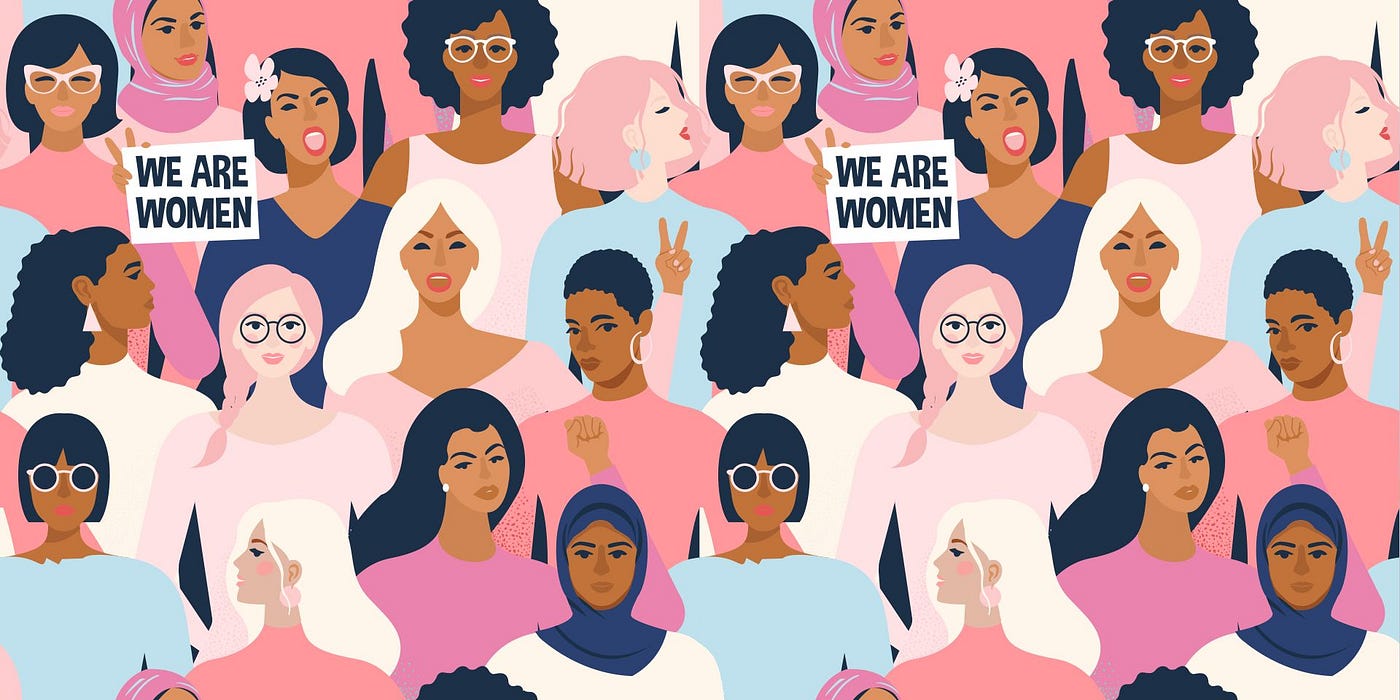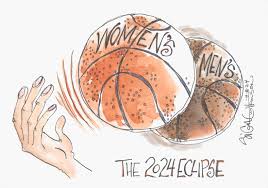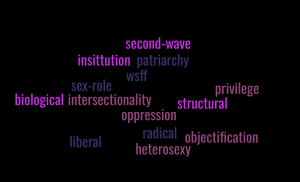Feminism is about working together as a team to create equality for everyone, regardless of gender. It focuses on supporting and empowering each other, whether you’re fighting for equal rights, opportunities, or respect. Just like a team, feminism is about independence, cooperation, and working together for a world where everyone is treated fairly. It is important for feminists to work with one another to support each others beliefs and to have their backs through the ups and downs when advocating.
1
Section One: The Fundamentals
A) What do we know about sport? What are common assumptions we make about sport and society?
Exercise 1: Before we go any further, I want you to take a moment and complete the phrases below:
While these statements might be true on one level, on another, they do not align with many people’s experience of sport, which brings us to our first class discussion forum.
Exercise 2: Padlet response
Speculate on why some of the statements/assumptions above might be untrue for some people or from a certain perspective. Is there anything your peers noted that surprised you? Comment on this as well.
[type below or paste in a screenshot of your padlet participation]
| As someone who has played sports their entire life, I would say that most of these are accurate. Sports have taught me various good characteristics that have helped me become who I am today. I have learned traits such as determination, a good hard work ethic, teamwork, time management, dedication, etc. All of these positive results of sports has allowed me to become a very collaborative and hard worker which now helps me out in many other ways in life even outside of sports. However, I am very shocked about the statement about politics being very little when it comes to sports. Unfortunately with last least in my experience, politics is a major part of games and often takes away the fun. For example, if the coach has a kid, that kid will always make the team no matter the skill which causes drama with other kids who don’t make the team. In addition, connections is a big part of sports and by this I mean, if a family knows someone involved in sports organizations, this means that kid is more likely to get on teams without putting the effort forward like everyone else. Overall, sports come with countless positive parts that have changed me as a person but it also comes with few negative components that can ruin a sport for anyone. |
Exercise 3: Notebook prompt
What are some other metanarratives about sport that you are familiar with? Find an image or video clip or draw something yourself that captures this idea…
So what? Why does any of this matter? Does it matter? As something we grow up with – live with – play through – we don’t often interrogate the meanings of sport, and perhaps we don’t want to.
But being aware of these assumptions and metanarratives is especially important, I would argue, because of the centrality of sport to our everyday lives, the role that sport plays in shaping our childhood and worldviews and….. [finish that thought]
| Here is a video that explains why sports are important for kids and what the benefits are outside of the actual sport:
Participating in sports and learning all of the skills that they provide us with is very important because it teaches us life skills. For example, growing up I had to balance competitive hockey, multiple high school sports, homework, work and a social life. Having all of these things on my plate and knowing that I had to be on time, prepared, and ready to go for the sports I played, I quickly learned time management skills. This has now helped me in the real world as now that I am in Univeristy, I know how to manage my time to hand assignment in on time, and when to start studying to prepare for a test. Therefore, playing a sport is a fun way to develop skills for the real world without even realizing.
|
B) What is social justice?
Exercise 4: Padlet Prompt
Think back to the last section and try to look at some of the ideas we discussed differently. How might sport and social justice actually co-exist?
Record any images, video clips, or gifs you added to the padlet and identify a point of intersection between sport and social justice (can be an issue or a barrier or a debate or something you would like to explore in more depth in this course) . Screenshot or paste in your response below.

As mentioned, I am a hockey player and have grown up seeing the many different situations of girls hockey. When I started we had very little female teams and had to travel far to play other teams and there was very little opportunity for us girls to continue hockey after a certain point. There originally was no professional girls hockey, then they tried to start a professional league but it failed numerous times because no one supported girls hockey. There were no fans going to the games to keep the league running financially and there was so much negativity over the internet. As we now know, women now have a professional league that has been very successful and this is because of the support we’ve received. This is because of help through social media with people advocating for women hockey players who want to fulfil their dreams in the sport Men have been lucky enough to always have had professional hockey available to them and for these reasons, male hockey players are very famous with large social media platforms. Luckily, various male hockey players used these platforms to advocate for female hockey players. This shows how social justice can take place within sports when players/teams who have found success help those who are still seeking.
|
C) Social Justice Reading
(note: this activity is optional!)
D) KINESIOLOGY AND SOCIAL JUSTICE
Exercise 5:
Exercise 6:
What are the implications of bodies-at-risk discourse and the refusal to understand the health gap from a social justice perspective, according to the authors of this article?
| The bodies-at-risk idea and ignoring the bigger social issues behind health gaps keep harmful stereotypes around in society and blame people for their own health problems. The article explains that this approach focuses on personal issues and negatives instead of looking at the bigger picture, like racism, ableism, and poverty. It doesn’t take into account how things like race, disability, and income affect people’s health, and it stops real change from happening. To fix health disparities, we need to focus on fairness and tackle the systems that cause these issues. |
Section Two: Sport Feminism
Exercise 7: Notebook Prompt
What is feminism? What does it mean to you? Choose one of the images below and explain how it captures your understanding of feminism (or find one that does speak to you and paste this into your pressbook with an explanation of why it matters to you.

|
Exercise 8: Notes Prompt (optional)
NB: Cornell notes is a great resource that teaches effective notetaking. Unfortunately, our system can’t save notes taken in the H5P app, so this is fully optional.
Exercise 9: Crossword Activity
Exercise 10: Padlet Prompt
Create your own word cloud including all of the important terms and concepts covered in the article that were not included in the crossword activity! (Record or screenshot your response below).
|
|
Exercise 11: Padlet Discussion Prompt (optional)

The illustration featured in this padlet (of a basketball with the word “women’s” eclipsing a basketball bearing the word “men’s” at the time of the solar eclipse) ran last year in a Philadelphia newspaper piece about how athletes like Angel Reese and Caitlin Clark were generating unprecedented enthusiasm for women’s sport. Do you feel the landscape is changing? Do people care about women’s sport?
| I do feel like people are starting to care more about women’s sports and are beginning to support female athletes with their careers. For example, recently I am sure most of us have seen the women PWHL (professional women hockey league) have an amazing start to their league. Womens professional hockey had been very much so a trial and error process while I was growing up as many professional leagues had been made but no one supported it and no money was put into it which caused it to fail. However the new PWHL has been very successful as many people are going to watch, even selling out stadiums, which has allowed the league to continue running as they now have the money to keep it going. Women feel more confident on the ice as there are more positive fans that are uplifting the players and giving them the opportunity to make careers out of hockey like men have been. However, there obviously are still some challenges as there is a decent group of people (mainly men) who talk down about the athletes saying that women are not good at hockey and that their league is boring in comparison to men. In addition, men are still being paid way more in the NHL but this will really just take time as the women need time to build up the PWHL more. Overall, I do believe more people support female sports and are excited about changing the sporting atmosphere for women, I just think it will take time to reach the level that men’s sports is at since this is all starting so late.
|


